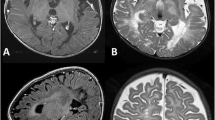Summary
Two cases of Lhermitte-Duclos disease or diffuse hypertrophy of the cerebellum are presented. This brings the total number of such cases reported in the literature to 42. Pathologically the disease is characterized by a circumscribed cerebellar lesion consisting of thickening of the cortex with closely packed dysplastic ganglion cells in the granular layer and with large myelinated axons in the molecular layer. Purkinje cells are missing and the central white matter is greatly reduced.
The first patient, a man 39 years of age, had, in association to the cerebellar lesion, a megalencephalic brain (2320 g). He had suffered from epilepsy since he was 24-years-old and died with metastasizing colon carcinoma. An electron microscopic study of the cerebellar lesion disclosed perikarya containing large amounts of rough endoplasmic reticulum, cell processes filled with coated and dense core vesicles. In addition, there were numerous enlarged myelinated axons in the molecular layer.
The second patient, a woman 74 years of age, had a small area of diffuse hypertrophy of the left cerebellar hemisphere measuring one centimeter in diameter.
Specific symptoms were very scant in the first case and absent in the second one indicating a very slow evolution — if any — of the disease process. The etiology and pathogenesis remain unknown. However, the organoid structure of the lesion, the frequent association of megalencephaly and other congenital abnormalities, and the occurrence of familiar cases would favor the disease being basically a developmental disorder.
Zusammenfassung
Es wird über zwei Fälle von Lhermitte-Duclos'scher Erkrankung bzw. diffuser Hypertrophie des Kleinhirns berichtet. Histopathologisch handelt es sich dabei um umschriebene Dysmorphien des Kleinhirns, die so charakteristisch sind, daß sie bei chirurgischer Exploration vom bloßen Auge erkannt werden können. Die vergröberten, hypertrophen Kleinhirnläppchen heben sich zudem durch eine unterschiedliche Färbung vom normalen Kleinhirn ab (Fig. 1). An Stelle der Körnerschicht gibt es dicht beieinanderliegende, dysplastische Ganglienzellen verschiedenen Typs (Fig. 3), die myelinisierte Axone (Fig. 7) in die dadurch stark myelinisierte Molekularschicht schicken. Die Purkinjezellschicht fehlt, die Marklamellen sind stark verschmälert. Die Läsion wird als Hamartom aufgefaßt; klinisch kann sie als Raumforderung der hinteren Schädelgrube in Erscheinung treten.
Die Mehrzahl der Patienten mit diffuser Kleinhirnhypertrophie haben zusätzlich andere gehäuft vorkommende Läsionen wie Megalencephalie, Schädelund Skelettanomalien, benigne und maligne extracerebrale Tumoren u. a. m.
Bei dem ersten Fall handelt es sich um einen 39jährigen Mann, der neben der diffusen Kleinhirnhypertrophie ein megalencephales Gehirn (2320 g) hatte, und an einem metastasierenden Coloncarcinom ad exitum gekommen ist. Im Alter von 34 Jahren ist eine 540 g schwere Struma entfernt worden. Die Ganglienzellnatur der dysplastischen Zellen der Körnerschicht ließ sich anhand des Nachweises von Synapsen (Fig. 6) und großen Nisslschollen (Fig. 5) elektronenmikroskopisch beweisen. Bei dem zweiten Fall handelt es sich um eine 74jährige Frau, deren Kleinhirnläsion — wie im ersten Fall — klinisch nicht in Erscheinung getreten ist.
Die Aetiopathologie ist nicht bekannt. Die organoide Struktur der cerebellären Läsion, die häufige Vergesellschaftung mit Megalencephalie und anderen Mißbildungen, sowie das Vorkommen von familiären Fällen macht es wahrscheinlich, daß es sich dabei um eine Entwicklungsstörung handelt. Die Lhermitte-Duclos'sche Erkrankung ist selten. Meines Wissens sind zur Zeit insgesamt 42 Fälle bekannt geworden.
Similar content being viewed by others
References
Ambler, M., S. Pogacar, R. Sidman: Lhermitte-Duclos disease (granule cell hypertrophy of the cerebellum). Pathological analysis of the first familial cases. J. Neuropath. exp. Neurol. 28 (1969) 622–647
Bellamy, J. C., N. A. D'Amato, J. E. Szakacs: Diffuse cerebellar hypertrophy. Amer. J. clin. Path. 40 (1963) 395–404
Bielschowsky, M., A. Simons: Über diffuse Hamartome (Ganglioneurome) des Kleinhirns und ihre Genese. J. Psychol. Neurol. (Lpz.) 41 (1930/31) 50–75
Christensen, E.: Über Ganglienzellgeschwülste im Gehirn. Virchows Arch. path. Anat. 300 (1937) 567–581
Cook, T., S. Holt, P. O. Yates: Diffuse Hypertrophy of the Cerebellum. J. Neurol. Neurosurg. Psychiat. 25 (1962) 218–221
Daum, M. S., R. Billet, J. Janau, J. Comoy: Ganglioneurome diffus du cortex cérébelleux (Maladie de Lhermitte et Duclos). Opéré avec succès. Neuro-Chirurgie 13 (1967) 665–671
Duncan, D., S. R. Snodgrass: Diffuse Hypertrophy of the Cerebellar Cortex (Myelinated Neurocytoma). Arch. Neurol. Psychiat. 50 (1943) 677–684
Ferrer, I., F. Isamat, J. Acebes: A Golgi and Electron Microscopic Study of a Dysplastic Gangliocytoma of the Cerebellum. Acta neuropath. (Berl.) 47 (1979) 163–165
Foerster, O., O. Gagel: Ein Fall von Gangliocytoma dysplasticum des Kleinhirns. Z. ges. Neurol. Psychiat. 146 (1933) 792–803
Hallervorden, J.: Über die Hamartome (Ganglioneurome) des Kleinhirns. Dtsch. Z. Nervenheilk. 179 (1959) 531–563
Leech, R. W., L. A. Christoferson, R. L. Gilbertson: Dysplastic gangliocytoma (Lhermitte-Duclos disease) of the cerebellum. J. Neurosurg. 47 (1977) 609–612
Lhermitte, J., P. Duclos: Sur un ganglioneurome diffus du cortex du cervelet. Bull. Ass. franc. Cancer 9 (1920) 99–107
Pritchett, P. S., T. I. King: Dysplastic Gangliocytoma of the Cerebellum — An Ultrastructural Study. Acta neuropathol. (Berl.) 42 (1978) 1–5
Rilliet, B., Y. Mori: Gangliocytome dysplastique du cervelet. Arch. Suisses Neurol. Neurochir. Psychiat. 124 (1979) 13–27
Rubinstein, L. J.: Tumors of the central nervous system. Armed Forces Institute of Pathology, Washington, D. C. 1972, pp. 164–167
Russel, D. S., L. J. Rubinstein: Pathology of Tumours of the Nervous System. Edward Arnold, London 1971, pp. 198–199
Zülch, K. J.: Biologie und Pathologie der Hirngeschwülste. In: Olivecrona, H., W. Tönnis: Handbuch der Neurochirurgie, Bd. III, pp. 394–395, Springer-Verlag, Berlin-Göttingen-Heidelberg 1956
Author information
Authors and Affiliations
Additional information
Dedicated to Professor Dr. K. J. Zülch on the occasion of his 70th birthday.
Rights and permissions
About this article
Cite this article
Gessaga, E.C. Lhermitte-Duclos disease (diffuse hypertrophy of the cerebellum). Report of two cases. Neurosurg. Rev. 3, 151–158 (1980). https://doi.org/10.1007/BF01644067
Issue Date:
DOI: https://doi.org/10.1007/BF01644067
Key-words
- Diffuse hypertrophy of the cerebellum
- Dysplastic cerebellar gangliocytoma
- Epilepsy
- Granule cell hypertrophy
- Hamartoma of the cerebellum
- Lhermitte-Duclos disease
- Megalencephaly
- Ultrastructure




